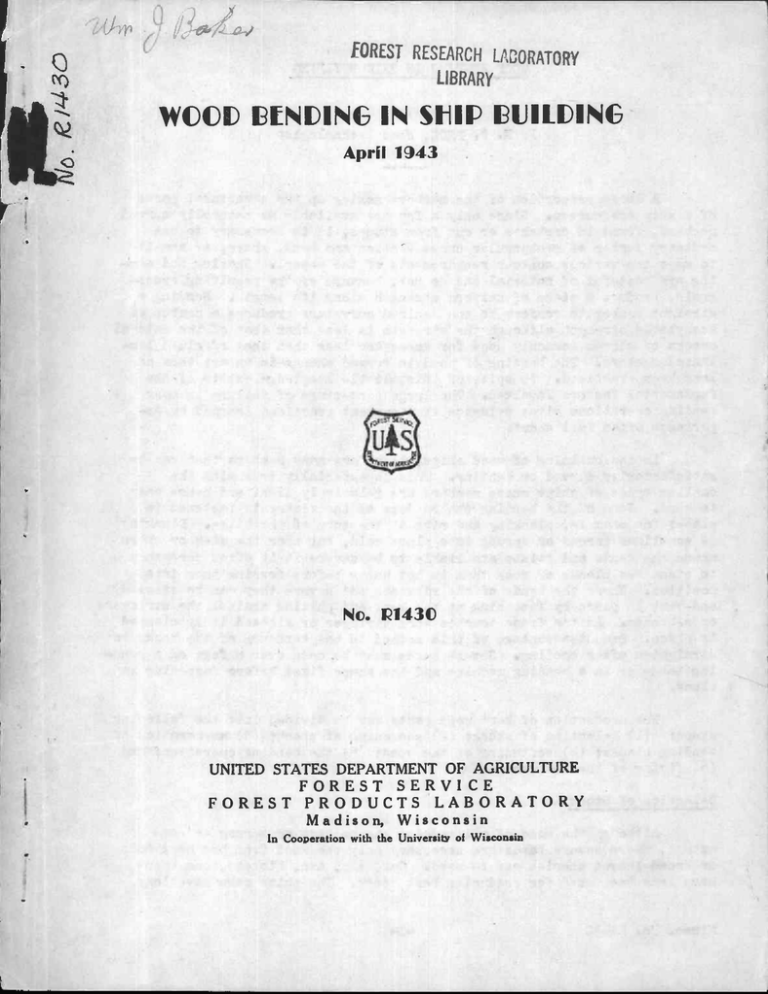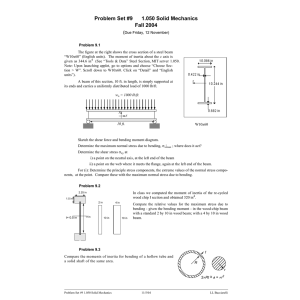WIDOID IBENIANC IN SHIP MIMING April 1943 No. 81430
advertisement

FOREST RESEARCH LACORATORY LIBRARY WIDOID IBENIANC IN SHIP MIMING April 1943 No. 81430 UNITED STATES DEPARTMENT OF AGRICULTURE FOREST SERVICE FOREST PRODUCTS LABORATORY Madison, Wisconsin In Cooperation with the University of Wisconsin WOOD PENDING IN SHIP BUILDING By E, 0, PECK, Wood Technologist A large proportion of the members making up the structural parts of a ship are curved. Since only a few are available as naturally curved members, found in crotches or cut from stumps, it is necessary to use ordinary lumber of rectangular cross section and bend, shape, or saw it to meet the various contour requirements of the vessel. Sharing and sawing are wasteful of material and do not, because of the resulting cross— grain, produce a piece of uniform strength along its length, Bending a straight member to conform to the desired curvature produces a member of acceptable strength although the strength is less than that of the natural crooks or curves commonly used for knees and less than that of glued laminated members. The bending of wood to curved shapes is an art that has long been p racticed. In spite of this, little knowledge , exists of the fundamental factors involved. The large percentage of failure in many bending operations gives evidence that current practices learned by experience often fall short. In the building of wood ships, there are many members that can be satisfactorily curved by bending. This is especially true with the smaller types of ships whose members are relatively light and hence easy to bend. Some of the bending can be done as the member is fastened in place; for example, planking and ribs at the turn of the bilge. Planking is sometimes forced or sprung into place cold, but near the stem or stern where the bends and twists are liable to be severe it is often necessary to steam the nlanks or soak them in hot water before forcing them into position. Where the bends of the ribs are net severe they can be steamed and bent in place by fastening at the keel and pulling against the stringers or ribbands. As the frame touches each stringor or ribband it is clamped in place. One disadvantage of this method is the tendency of the bends to straighten after cooling. Severe bends must be made over a form on a bending table or in a bending machine and the shape fixed before fastening in, place. The p roduction of bent wood parts may be divided into the following steps: (1) selection of stock; (2) seasoning of stock; (3) preparation of bending blanks; (4) softening of the wood; (5) the bending operation; and (6) fixing of the bent shape. Selection of Stock Although the wood of all species can be bent or sprung to some extent, where severe bonds are necessary only the wood from the hardwoods or broad,leaved species can be used. Oak, elm, ash, hickory, and beech have long been used for producing bent stock. The white oaks have long Uimeo. Yo. R1430 —1— been used in ship building and are preferred for bending. Not all pieces of wood from a species ordinarily used for bending are suitable. The wood must be straight—grained; the deviation in spiral or cross—grain should not exceed 1 inch in 15 inches. This applies to the grain of the piece as a whole and also to irregularit i es in the vicinity of knots and burls. The wood must be free from decay. Wood of high density is desirable because of its superior strength properties but with proper technique wood of high density or with a particular rate of growth is net essential to success in bending. Wood of high density has a high percentage of summerwood, but it is difficult to determine this percentage in hardwoods. An indirect method is to note the number and size of the pores. Defects such as knots, worm holes, shakes, and surface checks are detrimental, since they•tend to cause failures, but small sound knots near the ends, moderate surface checking, and scattered worm holes are permissible. A piece containing ring shakes or the heart center of the tree is not suitable for bending. Seasoning of Stock There is considerable difference of opinion regarding the best mois•. ture content of the stock at the time of bending. Bending is performed on wood whose moisture content ranges from the green condition down to 12 percent. Green wood with exceptionally high moisture content is not suitable for severe bends because hydrostatic pressure may develop en the side in contact with the form and cause compression failures. From a theoretical standpoint the optimum moisture content is probably in the vicinity of the fiber—saturation point, from 25 to 30 percent moisture content. Since wood for bending cannot be kept long in the green condition without the development of stain and decay (exeept during cold weather) most stock must undergo some seasoning before bending. Material cut during warm weather must be protected from sun and rain and piled on stickers, while waiting shipment. On arrival at the ship building plant the stock shoula be piled on stickers ither in a shed or in an air seasoning pile protected from sun and precipi€R7 Luring cold weather less stringent precautions are required-because stain and decay organisms are relatively inactive. It is good practice to apply a moisture resistant . coating to the ends of the pieces (immediately after they are cut) to reduce the amount of end checking and end splitting. Preparation of Bending Blanks Pieces for any particular bend should be trimmed to uniform length with the ends square with the length. The depth should be kept to a minimum with enough allowance for shrinkage. To prevent side buckling t}e width should be greater than the depth. Pieces are sometimes bent in multiples of desired widths and sawed after bending. Surfacing the side next to the form and the two adjacent faces will reduce the danger of compression failure. Yo. R1430 —2— Softening of the Wood . When wood is both wet and hot its plasticity is increased. This phenomenon is more marked in hardwoods than in conifers, thus hardwoods can be bent more successfully. The usual practice is to steam the wood in a box, in the presence of water, at approximately atmospheric pressure, or to submerge the wood in boiling water. The steaming or soaking time is about 1 hour per inch of thickness. Chemicals have been used to render wood more plastic, but this method of preparing wood for bending has not been thoroughly investigated. The Bending Operation After softening, stock that is to be given severe bends should be placed in a "bending apparatus as quickly as possible, with the previously dressed best side next to the form. Although mild bends can be made without end pressure, severe bends require a strap, with end fittings or blocks, app lied on the tension side, which is the outside of the bend. This strap is designed to prohibit tension failures. With an adequate strap and properly designed end blocks, with means of adjusting the end pressure,-practically all of the change in length between the two sides can be forced to take place as upset, a maximum at the concave side and a minimum at the convex side. The end blocks must be provided "with means for relieving the end pressure as bending progresses. The end pressure can be gradually reduced as bending progresses by utilizing a screw adjustment, or by placing, between the ends of the stick and the end blocks of the strap, blocks of rood that receive the pressure on the side grain and crush as bending progresses. It is necessary to design the a pparatus so that the end blocks will not overturn, and to design so that the p iece is not permitted to acquire a reverse bend in the vicinity of the ends (figs. 1, 2, & 3). As the bend progresses the area in early contact with the form hes a tendency to back away. To counteract this tendency, pressure to hold the portion already bent against the form must be provided. Experience and observations have shown that in making severe bends the most essential feature of the whole operation is the maintenance of strap tension and end pressure during the formation of the bend. The reversed lever principle as illustrated in figure 4 is one of the most effective ways of controlling end pressure and strap tension. This principle is embodied in the bending apparatus shown in figure 5. After constructing and using an apparatus of this type one boat builder reported that practically all of his former bending loss of 50 percent had been eliminated. Any boat shop should be able to make a similar apparatus that embodies the same principles but whose dimensions and other details of construction are adapted to the bent parts being produced. Fixing of the Bent Shape In order to make the bend permanent the wood must be cooled and dried under restraint. This is commonly done by nailing across the bent piece one or more stay-laths that are allowed to remain until the piece mimeo. No. R1430 -3- has seasoned enough to hold its shape. Sometimes tension failures, on the outer side of the curve, take place during this drying process. To prevent this a minor strap is sometimes applied to the piece before bending. After bending, a chain is attached to the ends of this strap, which assists in holding the shape of the piece and in retaining sufficient end pressure to prevent tension failure during seasoning. Sometimes bent parts check severely during cooling. Such checking is likely to be severe in stock that is bent while green or partially seasoned. Heat stored i inthe bending blank during the softening process causes very rapid evaporation. Vhen the piece is cooled in the air after bending shrinkage occurs in surface layers . before the interior of the piece has lost sufficient moisture to cause it to shrink. Cooling under weter at normal temperature prevents this rapid evaporation and permits the subsequent drying to take place more slowly. Yimeo ro. 81430 -4- • B Figure 1.-eDiagreamatio •kstoh of a banding strap having ineffective short end blocks. A, Before pressure (P) to applied, B, after pressure ie applied. Note how end bloom tip over and elide off. Figure 2.--Diagraamatic sketch showing revere. Lend near end with one type of bending gear. n Figure 3.--Magranmatio eketob showing reveres bend Geer end oaueed by too short • reversed lever arm on the end block. Z LS 46495 F Figure 4.--Dlagraamatio skstob showing proper application of the reversed lever prinoiple. n 0• a) ••• O p l • O A 0 m 4-1-P O CI 0 o ° CI-4 c" 0° 0 0 •r-1 .0 R. 0 .4 0 4) ▪ .0 . 0 0 -P co+) 0 0 0 0 -n-n L q q C-1 0 q q 1-1 43 oi -P 0 co -P DS '0 al Cd q g rl a) co co '0 °2 qi 0 .0 • .• cs-1 0 0-1 O 0 O 0 LD c.-1 4) 0 g L 0 0 qd -4 0 0 ".-1 0 0 • 0 Co -P -P q 0 .M td r-i • 0 0 •=-1 .s1 m .p ,0 to fa, 0 0 q 0 0 C) 4-1 1-1 0 0 al 0-1 4-) .0 q q to 0 g 0 -1 0• p Co 0 -P PIL00 , -P c.. P, m • -H L •• 100 ..cD - 'do 0 0 c.-L .0 0 _p 4-4 • -1-.) -P • g—14g • cd-P,—rco (1100 0 0 0 a>▪ -P A. 0 0 0 E r to)0CD 2 iJ 4.9 .t0) 0 rai L • • 0 4-) 0 0 LI, O P +) 'D .0 c° cD O 4) co LO 0 to ca -q 4: 0 0 rd z 40 0 L01 • co 0 b.0 a> H A-) co 1., t4 Ca L 0 0 •-; co 0 0 r—t 0 CO 0 a .p co q _p 0 0 a> La -114 q R. 11) 0 0 0 0 0 '0 co R, co 174A g 4.1 0 4-) as '0 ho ,o A-4 4) 0 0 .0 to r.x) 031 co) si cl, (d 110 Ac, en ro O I 0 m a) 0 ,0 P--4 0 0 0 -4:1;)1 O lel c_. • .1-1 - 0 0 -P • O m 0.. O • LC\ b0 14-% 1 •







